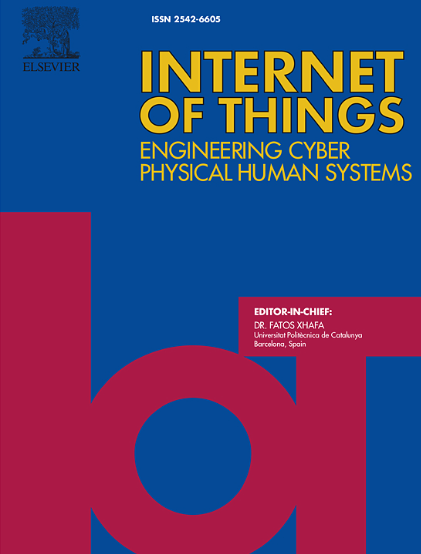基于码本值预测的毫米波波束路径阻塞预防
IF 6
3区 计算机科学
Q1 COMPUTER SCIENCE, INFORMATION SYSTEMS
引用次数: 0
摘要
使用毫米和太赫兹频谱进行通信对阻挡信号波束路径的障碍物非常敏感。波束角码本值可用于控制波束操作角度以防止阻塞,但这需要预测被阻塞的波束路径。预测管道的性能可能受到领域因素的影响,如操作环境的物理特性和特定的阻塞物。这可以通过人为地在训练和测试数据子集之间引入域因子转移来说明,其中特定的域因子被排除在训练子集之外。我们的实验表明,在包含特定域因子的所有样本的遗漏测试子集折叠上,阻塞预测性能显着下降。因此,预测管道必须采用有效的域移缓解技术,以在不同的域中获得一致的预测性能。管道性能应由逻辑输入数据支持,以预测因果关系。我们通过Shapley重要性值来量化因果关系,输入区域可归因于信号方面,如线性阵列天线。Shapley重要度结果表明,神经网络预测置信度对振幅方差和有限的后续快时间块有很高的影响。随机电感偏卷积的影响在有限数量的空间分离天线中是不同的。当输入数据区域为零掩蔽时,由于内部提取机制和时间复杂度的增加,迭代分量搜索具有同样高的预测置信度影响。我们将同样高的假设预测置信度对迭代分量搜索的影响与高度逻辑中频信号与预测因果关系联系起来。振幅方差和有限的后续快时间块的影响显示出较弱的因果关系,如果神经网络可以在不同距离和角度组合集的表示分布中分离观测值,则仍然被认为是逻辑的。随机的归纳偏置卷积表现出非逻辑的因果关系。它们依赖于直接中频信号特性。天线数量有限的影响表明依赖于在适当分辨率下沿角度分离能力不足的特征。本文章由计算机程序翻译,如有差异,请以英文原文为准。

MmWave beam path blockage prevention through codebook value prediction under domain shift
Use of millimeter and terahertz spectra for communication is very sensitive to obstacles blocking signal beam paths. Beam angle codebook values can be adapted to control beam operation angles for blockage prevention, but this requires prediction of beam paths that are blocked. The performance of the prediction pipeline may be affected by domain factors such as physical characteristics of an operation environment and a specific blocker. This can be illustrated by artificially introducing domain factor shifts between training and test data subsets where a specific domain factor is left out of the training subset. Our experiments reveal significant performance drops in the blockage prediction performance on left-out test subset folds that contain all the samples of a specific domain factor. Thus, the prediction pipeline must employ effective domain shift mitigation techniques to attain consistent prediction performance in different domains. Pipeline performance should be supported by logical input data to prediction causation. We quantify causation by means of Shapley importance values with input regions attributable to signal aspects such as linear array antennas. Shapley importance results show high neural network prediction confidence value affection for amplitude variance and a limited set of subsequent fast-time blocks. Random inductively biased convolutions affection differs in a limited number of spatially separated antennas causing affection. Equally high prediction confidence value affection is assumed for iterative component search due to internal extraction mechanics and time complexity increases when zero-masking input data regions. We link equally high assumed prediction confidence value affection for iterative component search to highly logical IF signal to prediction causation. The affection of amplitude variance and a limited set of subsequent fast-time blocks shows weaker causation, still considered logical if the neural network can separate observations in representation distributions for varying distance and angle combination sets. The random inductively biased convolutions show illogical causation. They rely on direct IF signal features. Affection by a limited number of antennas indicates reliance on features with inadequate separation ability along angles at appropriate resolution.
求助全文
通过发布文献求助,成功后即可免费获取论文全文。
去求助
来源期刊

Internet of Things
Multiple-
CiteScore
3.60
自引率
5.10%
发文量
115
审稿时长
37 days
期刊介绍:
Internet of Things; Engineering Cyber Physical Human Systems is a comprehensive journal encouraging cross collaboration between researchers, engineers and practitioners in the field of IoT & Cyber Physical Human Systems. The journal offers a unique platform to exchange scientific information on the entire breadth of technology, science, and societal applications of the IoT.
The journal will place a high priority on timely publication, and provide a home for high quality.
Furthermore, IOT is interested in publishing topical Special Issues on any aspect of IOT.
 求助内容:
求助内容: 应助结果提醒方式:
应助结果提醒方式:


